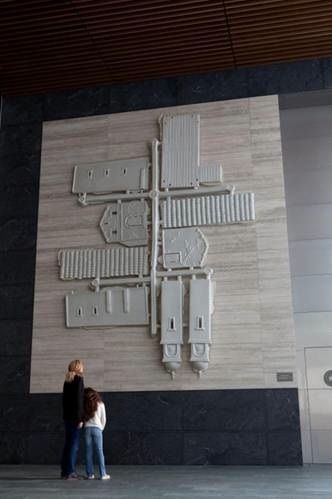Working in the Financial district, you could pass the sleek, tinted glass exterior of Millennium Tower (301 Mission Street) daily without noticing the rare contents of its street level atrium. Those with the curiosity to enter will find what was set aside for them: A cool place for workday respite, containing three world class sculptural and installation works of contemporary art, two by local artists.
We owe this in part to the city of San Francisco, which requires major developers to allocate a certain percentage of their budget toward public art. But whereas many developers would see this as a formality, pick an internationally recognized artist at random and sign the paperwork, Millennium founding partner Philip Aarons takes the responsibility more seriously. An avid collector of modern and contemporary art, he embraces the opportunity to showcase carefully (and democratically) selected, thoughtful local work.
Inside the serene space, a hyper-pixelated backdrop ostensibly depicting Napa Valley redwoods, by Amanda Weil Studio, plays against Catherine Wagner’s Vitreous Bench, a sculpture-cum-seating object that evokes a synthetic frozen pond containing suspended acorns. Last week, Aarons proudly unveiled the space’s third work, an 18 x 14 foot model of the Spanish mission from which the street gets its name, by Yoram Wolberger.
Next time you’re grubbing at the SOMA food truck stop up the street, take a moment afterwards to stop into the atrium, digest, and contemplate some very well-placed art.
Contemporary Painting, 1960 to the Present, at SFMOMA
Since the first daguerreotype in 1839, every advance in photo, film and digital technology has struck painting like a mortal challenge. And compared to Richard Serra’s industrial-grade steel sculptures, Rineke Dijkstra’s ultra-high resolution photographic portraiture, Jim Campbell’s twinkling LED light installation and most of the other exhibitions that have rolled through SFMOMA since The Stein’s Collect, painting does seem rather quaint.
“Painting is dead” has been declared a hilarious amount of times by this point, yet the medium proves resilient – still easily the most popular way to make art. Contemporary Painting makes for a wonderfully educational experience with regard to this apparent paradox. In recapping how painting has evolved over the past fifty years and showing where it stands now, the exhibition will remind you why liquid-based pigment remains such an irreplaceable avenue for expression.
Progressing in roughly chronological order, the exhibition’s first half offers the usual lineup of midcentury heavy hitters: Andy Warhol’s silkscreen meditations on Elizabeth Taylor, Wayne Thiebaud’s acrylic-frosted cakes, Kenneth Noland’s nearly monochromatic color fields (no Rothko, strangely, but you can head down to the museum’s second floor for that), Frank Stella’s geometric double chevron and Cy Twombly’s chalkboard-esque scribblings.
One sees a clear, unified artistic narrative unfolding throughout these rooms – one pushing away from traditional figuration, toward various forms of abstraction. There were dissidents – Joan Brown’s magnificent Girl Bathing by Night is a triumphant example of figurative representation coexisting with abstract expressionism – but sure enough, these are not household names.
The exhibition’s turning point occurs in a gallery with four artists who, in the 1980s and 1990s, produced work examining not their medium, but rather their social world and personal realities, in particular the pressing issue of the AIDS crisis and gay identity. The works range from massive, glossy, cartoonish panels, as in David Dashiell’s Queer Mysteries series, to hyperrealism, to mixed media assemblage. It is as though the preceding midcentury narrative collapsed under the weight of its own monochromatic philosophizing, and then exploded in every available direction.
Since this veritable Big Bang, contemporary painting has known no bounds, in subject matter or style. Contemporary Painting’s latter galleries house an astonishingly diverse array of works, from bristling abstraction to conventional figuration, street art to bejeweled, elephant dung-encrusted portraiture. In spite of its routinely forecasted extinction, painting today is positively overflowing. It has also become utterly impossible to compartmentalize, and is all the richer for it.
Contemporary Painting runs through August 12, 2012, at SFMOMA, 151 3rd Street
Related Articles
